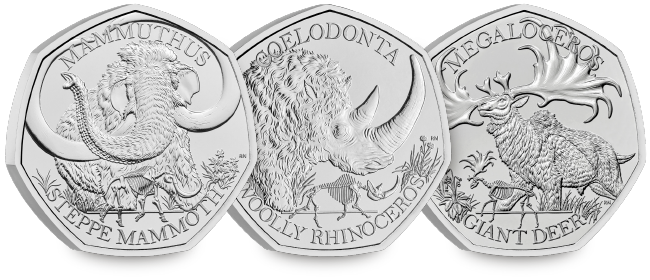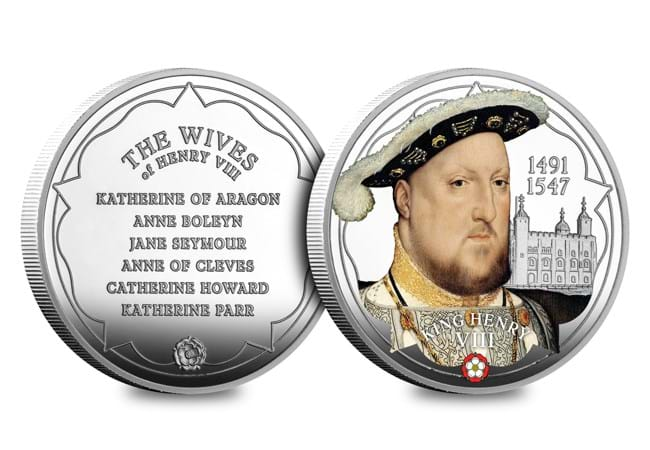50p Coin
Discover the 2025 Annual Sets
As we welcome 2025, there’s no better way to mark the occasion than with The official brand new 2025 Annual Sets — a stunning collection of coins celebrating the people, places, and events that have shaped British history. Each coin captures a defining moment, bringing history to life in a way that feels more meaningful than ever at this time of year.
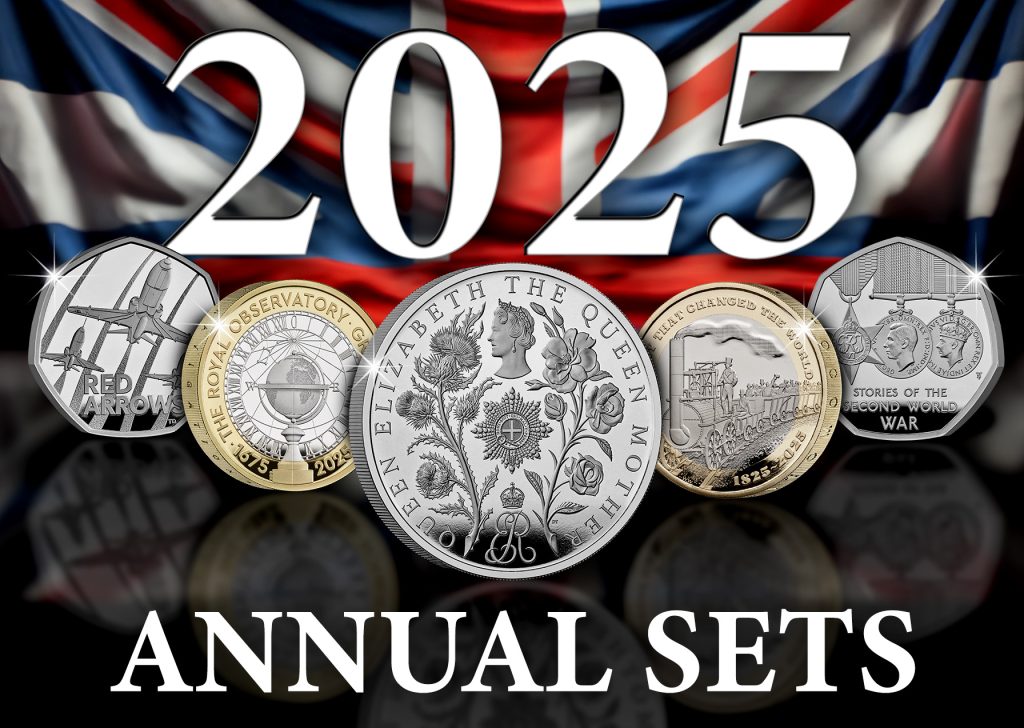
Available on 2nd January 2025
Here’s a closer look at the stories behind these commemorative coins:
Marking the Birth of Queen Elizabeth The Queen Mother
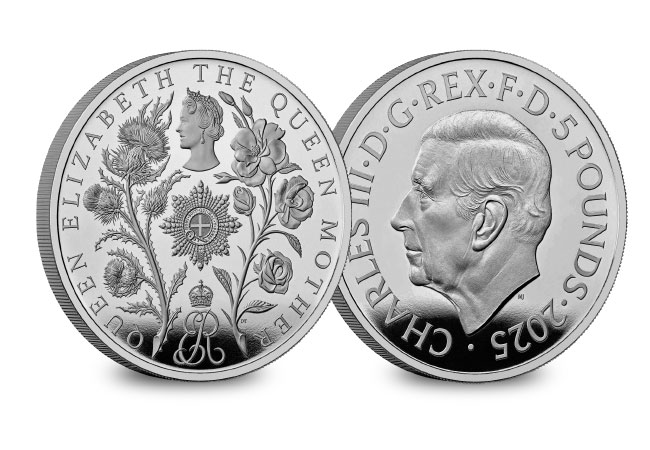
Queen Elizabeth The Queen Mother is celebrated for her steadfast resilience and unwavering support during some of the most challenging times in British history, including the Second World War. As a pillar of strength to her husband, George VI, and her daughter, Queen Elizabeth II, her influence spanned over a century. The £5 coin dedicated to her features a reverse design with a portrait that previously graced the coin celebrating her 80th birthday in 1980—a timeless tribute to her enduring legacy.
200 Years of the Modern Railway
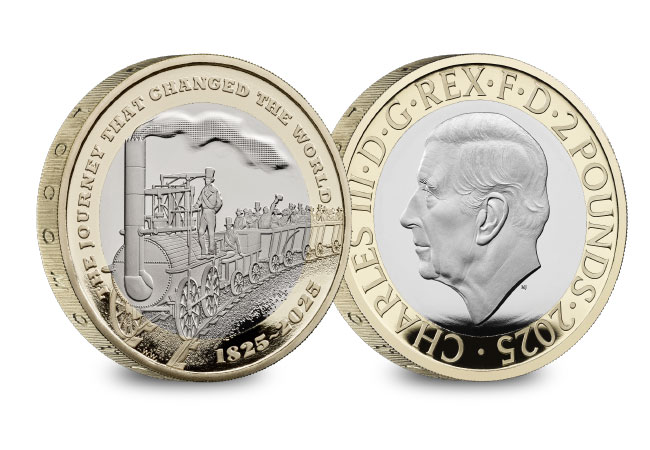
On 27 September 1825, George Stephenson’s Locomotion No. 1 revolutionised travel by transporting hundreds of passengers between Shildon, Darlington, and Stockton. This historic journey not only marked the dawn of the railway age but also transformed industries and cultures worldwide. The £2 coin commemorating this milestone captures the essence of that pivotal moment with a reverse design depicting Locomotion No. 1, paired with the edge inscription, “ACTIVE · LOCOMOTION NO 1.” This coin serves as a tribute to two centuries of innovation and progress in rail travel.
350 Years of The Royal Observatory, Greenwich
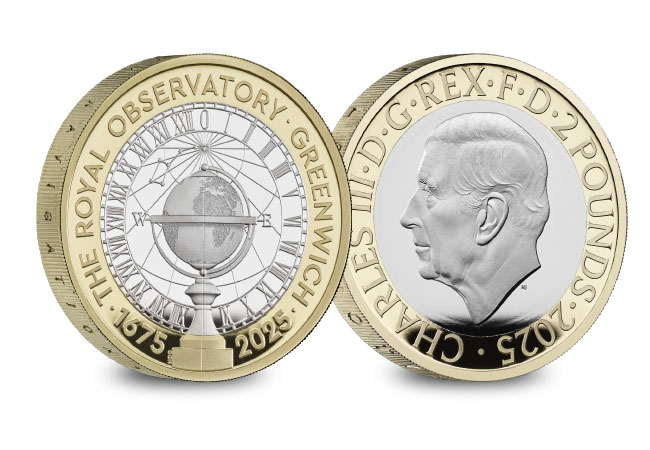
Founded in 1675 by Charles II, the Royal Observatory, Greenwich, has been a beacon of scientific progress, defining global navigation and timekeeping. The £2 coin commemorates its 350th anniversary with a reverse design that integrates the Shepherd Gate Clock, the constellation Ursa Minor, Polaris, and the iconic meridian line against a globe backdrop. Its edge inscription, “PERFECTING THE ART OF NAVIGATION,” underscores the Observatory’s enduring legacy.
Celebrating the Red Arrows
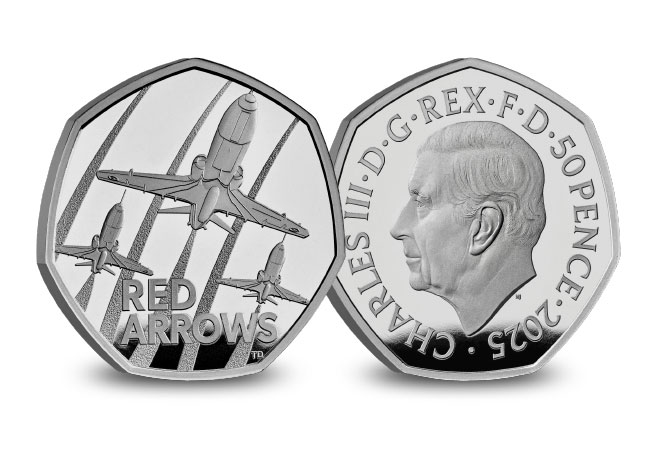
Since their inception in 1964, the Red Arrows have dazzled millions with their breath-taking aerobatic displays. Representing the precision and agility of the Royal Air Force, the team has performed nearly 5,000 displays across 57 countries. The 50p coin celebrating the Red Arrows features the sleek Hawk T1 aircraft, a tribute to the team’s inspiring legacy and their continued excellence in aviation.
Remembering the Stories of the Second World War
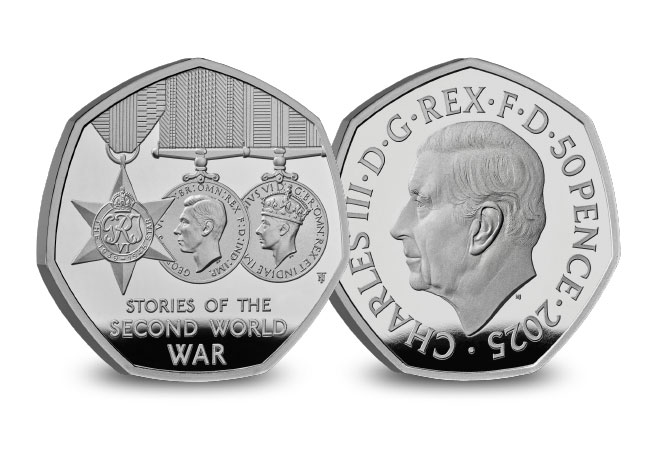
The Second World War was a defining chapter in British history, with contributions from soldiers, factory workers, and citizens alike. The 50p coin honours this collective effort with a reverse design showcasing the 1939–45 Star, Defence Medal, and War Medal—symbols of the bravery and resilience demonstrated during the war. Each medal tells a story of personal sacrifice and national unity that shaped the Britain we know today.
The Obverse: His Majesty King Charles III
Every coin in the 2025 Annual Sets bears the official coinage portrait of His Majesty King Charles III. Designed by Martin Jennings in 2022, this is the first definitive coinage portrait of
His Majesty The King to appear on coins, symbolising the continuity of the monarchy and the evolving story of the United Kingdom.

A Testament to British History and Craftsmanship
Each coin is meticulously crafted, embodying The Royal Mint’s dedication to excellence and storytelling. These sets not only celebrate the past but also inspire future generations to cherish and learn from Britain’s rich cultural heritage.
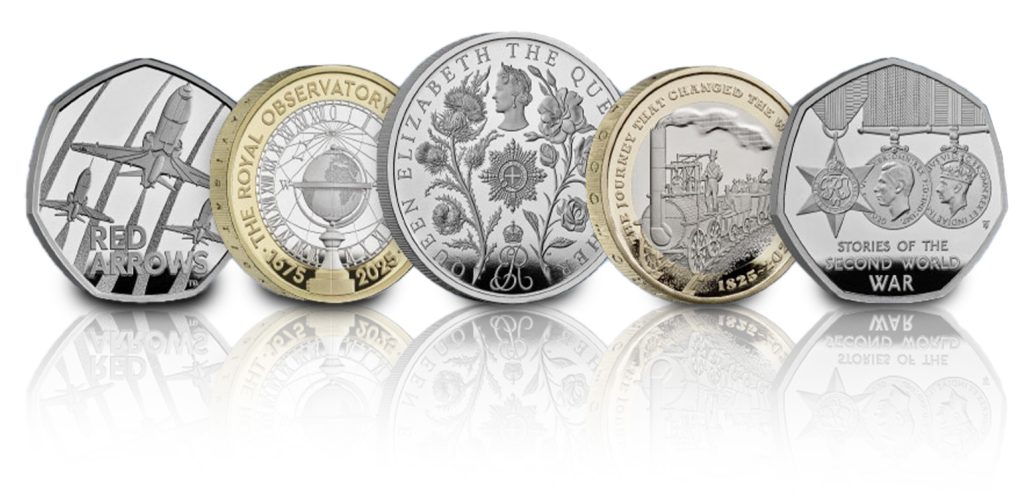
Available on 2nd January 2025
As stated by the Royal Mint
Tudor England: A Pop Culture Phenomenon That Never Fades
Over 500 years have passed since Henry VIII ruled England, but the Tudor dynasty continues to captivate hearts and minds across the globe. From the West End to prime-time TV, the Tudors remain an enduring source of fascination, blending drama, romance, intrigue, and sheer opulence. Let’s explore why this fascinating chapter of history remains such a vibrant part of today’s pop culture.
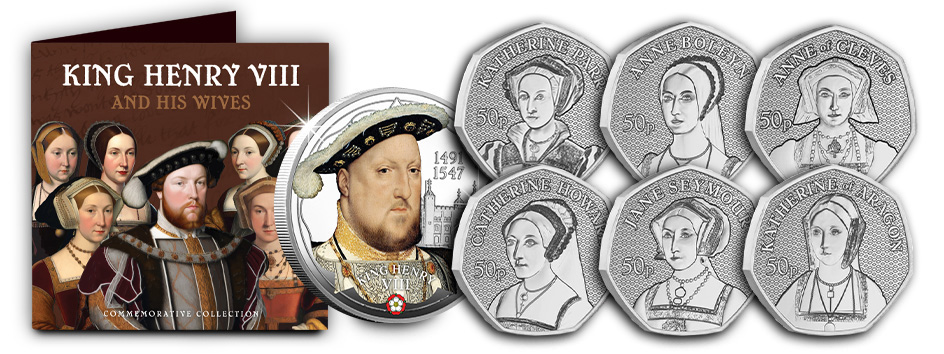
On Stage and Screen
One of the most dazzling examples of Tudor history thriving in modern entertainment is SIX: The Musical. This sensational stage production reimagines the lives of Henry VIII’s six wives as a pop concert, blending history with empowering anthems. Each queen tells her side of the story in a high-energy, feminist reworking of their tales, turning tragic endings into bold declarations of independence. The show’s global success proves that even centuries-old stories can have a modern voice.
Credit – https://sixonbroadway.com/ Youtube Channel – https://www.youtube.com/@sixglobal
Meanwhile, dramas like the BBC’s Wolf Hall and The Tudors bring Tudor England to life on screen with breathtaking visuals and riveting storytelling. These series capture the drama of court life, from Anne Boleyn’s rise and fall to Thomas Cromwell’s machinations behind the throne. Their cinematic portrayal keeps audiences hooked, proving that historical figures like Henry VIII are as compelling as any fictional character.
Watch the BBC first on iPlayer 👉 https://bbc.in/iPlayer-Home
Fashioning the Past: Tudor Style in Modern Media
Tudor fashion and iconography are unmistakable. Who can forget the opulent gowns, towering headdresses, or Henry VIII’s iconic fur-trimmed robes? These elements regularly influence everything from runway shows to film costuming, where echoes of Tudor grandeur and style are reinterpreted in new and creative ways. Even in modern art and advertising, the distinctive visual style of the Tudors continues to inspire.
Endless Drama: Why We Love the Tudors
The Tudors’ stories read like a script for the ultimate soap opera. Love, betrayal, power struggles, and executions—these timeless themes resonate across generations. The larger-than-life personas of Henry VIII and his wives bring unparalleled drama, making them a source of inspiration for writers, directors, and artists.
Celebrating Tudor England Through Collectibles
For history enthusiasts and collectors, tangible connections to this era, like collectible coins or commemoratives, offer a a unique way to immortalise Tudor history. Our exclusive range of products featuring Henry VIII and his wives captures the essence of this fascinating period. Each item is a tribute to the characters and stories that continue to inspire books, plays, and films.
From stage musicals to prestige dramas, the Tudors have a unique ability to bridge the gap between history and pop culture. Their enduring appeal lies in the rich tapestry of their lives, full of triumphs and tragedies that continue to resonate. Whether you’re a fan of SIX, Wolf Hall, or simply fascinated by the legacy of this iconic dynasty, the Tudors prove that history is never truly in the past—it’s alive, dynamic, and endlessly inspiring.
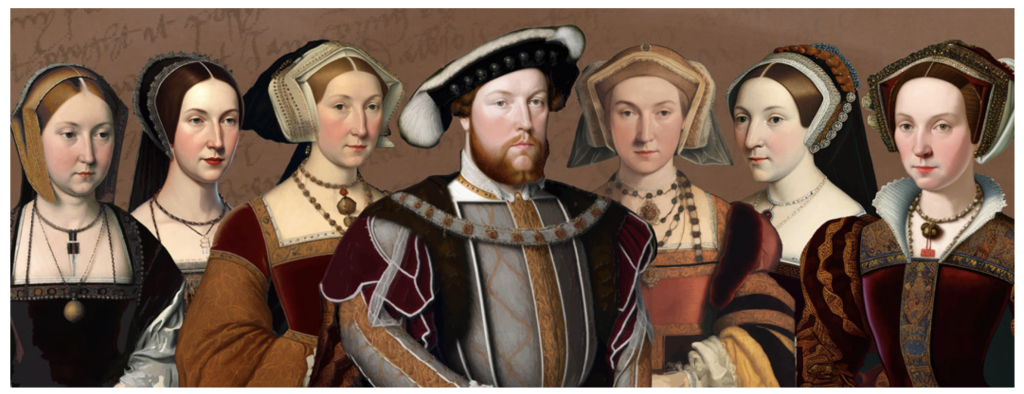

Explore the Ice Age Giants 50p series

The Royal Mint’s Tales of the Earth collection continues to captivate with a new series of coins that celebrate the awe-inspiring megafauna of the Ice Age. These coins depict three of the most iconic large mammals of the Pleistocene Epoch, a period that began 2.6 million years ago when vast ice sheets covered large parts of the Earth. While these glaciers dominated the landscape, immense creatures known as megafauna thrived in the grasslands nearby, and the latest UK 50p coins honour these giants in stunning detail.
The Mighty Steppe Mammoth

The first coin in the series features Mammuthus trogontherii, the colossal Steppe Mammoth. One of the largest mammals to exist during the Pleistocene Epoch, the steppe mammoth stood an impressive 4 meters tall at the shoulder and weighed up to 10 tonnes. Thought to have evolved from an ancestor in China around 2 million years ago, this giant herbivore adapted to changing environments with notable features. Its molars developed more ridges to better withstand abrasive vegetation, a critical adaptation that distinguished it from other mammoth species.


The Hardy Woolly Rhinoceros

Next in the series is the Woolly Rhinoceros UK 50p Coin, which highlights this remarkable creature that once roamed the grassy plains of the Ice Age. Despite being similar in size to today’s African white rhinoceros—around 2 tonnes—the woolly rhinoceros was well-suited for freezing conditions. Its thick double-layered coat protected it from temperatures as low as -60°C, and its long, sabre-like front horn likely helped clear snow in search of vegetation.


The Majestic Giant Deer

The final coin in this breathtaking series honours the Giant Deer, or Megaloceros giganteus. Known for its colossal antlers, which were the largest of any known species (measuring between 2.5 and 3.5 meters across), the giant deer was truly a sight to behold. With a shoulder height just under 2 meters—about the height of an average doorframe—this megafauna species managed to thrive in both the colder and warmer climates of the Ice Age, often coexisting with the woolly mammoth in more southerly areas.


This Icy 50p coin range from the Royal Mint’s Tales of the Earth series beautifully commemorates the grandeur of the Ice Age and it’s extraordinary creatures. From the towering Steppe Mammoth to the resilient Woolly Rhinoceros and the majestic Giant Deer, each coin is a tribute to a bygone era of natural wonders. Crafted with expert attention to detail and scientific accuracy, these coins are a must-have.
